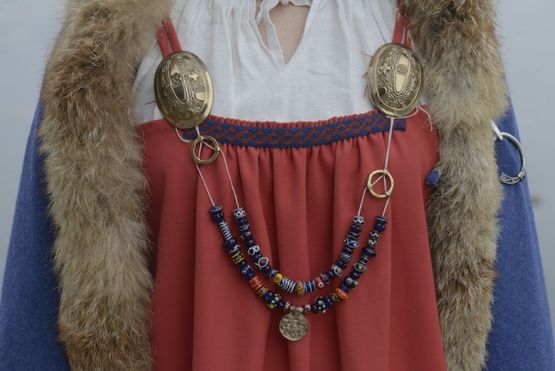
The Vikings’ appearance, clothes and ornaments
If you ask somebody today to describe the appearance of a Viking, you will often receive an answer along these lines:
A large, strongly-built man with long hair and a beard. Bearing a sword, an axe an a shield and wearing a helmet with horns!
But did the Vikings really look like this? The only horned helmets which have been found are from the Bronze Age, i.e. 1300 years before the Viking Age. There were also women and children in Viking times – and were all Vikings warriors? By taking a closer look at burial finds and the Vikings' own images of themselves we may get a little closer to the truth.
- Examine the appearance of the Vikings, their clothing and their ornaments on the basis of the burial finds mentioned on this website.
- Find other burial finds on the Internet and use them for further information.
- What is found in the graves?
- In what type of grave is there the greatest chance of finding remains of clothing? And why?
- How would a man be dressed?
- How would a woman be dressed?
- Draw a Viking woman and label her individual articles of clothing – what are they made of, how are they made and when did the woman wear them?
- Examine figures and picture stones. What can these tell us about the Vikings' appearance?
- What did the foreigners who met the Vikings think about their hygiene standards and appearance? Were they all of the same opinion? Why/why not?
The many beads, neck and arm rings and fine brooches in rich Vikings' graves show that the Vikings were inordinately fond of finery.
- Find out how ornaments were made in the Viking Age and who wore them
- Design your own Viking ornament. 1) For a man. 2) For a woman.
- Are there differences between the Viking ornaments for men and women?
- Make a ”Torshammer” (Thor's hammer) in bone.
The appearance of the Viking
This exercise contains problems and suggestions for practical activities as well as the worksheet Thor's hammer made of bone.
It deals with topics such as:
- The Viking's appearance
- The Viking's clothes
- The Viking's jewellery
- Sources on the Vikings' appearance, clothes and jewellery
- Images of the Viking
The following places and themes may help in solving the exercise:
- What did the Vikings look like?
- Lewis
- Ballyholme
- Woodstown
- Dublin
- Larne
- Isle of Man
- Lindholm Høje
- Eigg
- Colonsay
- Brough of Birsay
- Archaeological sources for the Viking Age
- Iconographic sources for the Viking Age
- Barber-surgeon
- Nurse
Encourage the pupils to use the library and the Internet for further studies. Direct them towards information on burial sites and various pictorial representations from the Viking Age, for example The Mammen Grave, The Bayeux Tapestry and the Gotlandic picture stones.
Teaching could begin with the pupils being asked to draw or paint their own interpretation of a Viking. Later, the pupils can find pictorial representations of Vikings from various periods or contexts (or the teacher can find and provide these). Use these, together with their own drawings, as a basis for a discussion of why the Vikings have been perceived and represented differently in different periods and in different situations.
The exercise is primarily intended for the ages 10-15 but the theme on Images of the Viking could be used for the ages 16-20 by forming the basis for a discussion of our (mis)use of the past in the present and our historical consciousness. SeeImages of the Vikingand the linked questionnaire. The teaching course Images of the Viking can also be booked at the Viking Ship Museum.
Subjects: Needlework, Art, Science and Technology, History, English.
Suitable for age: 10-20 years.